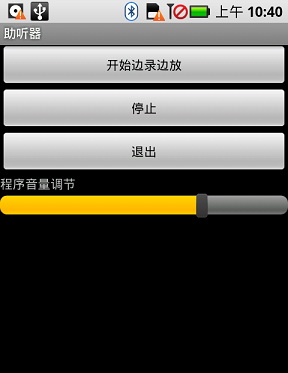
- Android之采用execSQL与rawQuery方法完成数据的添删改查操作详解
- AndroidHttpClient详解及调用示例
- Android中AsyncTask详细介绍
- Android动画之渐变动画(Tween Animation)详解 (渐变、缩放、位移、旋转)
- Android开发之使用GridView展示图片的方法
- Android调用堆栈跟踪实例分析
- android,不显示标题的方法小例子
- android开发中使用java观察者模式
- Android编程实现webview执行loadUrl时隐藏键盘的workround效果
- ListView异步加载图片实现思路(优化篇)
- [Android开发视频教学]01_09_Activity布局初步(一)
- android ListView和GridView拖拽移位实现代码
- Android 不同Activity间数据的传递 Bundle对象的应用
- Android中的SQL查询语句LIKE绑定参数问题解决办法(sqlite数据库)
- android动态布局之动态加入TextView和ListView的方法
- Android中监听未接来电的2种方法
- Android带进度的圆形进度条
- Android中使用Vectors(2)绘制优美的路径动画
- Android获取应用程序名称(ApplicationName)示例
- Android Intent启动别的应用实现方法
- 实例详解Android 获取短信会话列表
- 从Cocos2d-x2迁移到Cocos2d-x3的过程分享
- Android图片特效:黑白特效、圆角效果、高斯模糊
- Android 再按一次返回键退出程序实现思路
- Android实现为ListView同时设置点击时的背景和点击松手之后的背景
- Android WebView上实现JavaScript与Java交互
- [Android开发从零开始].19.Status.Bar.Notifications
- Android中进程生命周期的优先级
- Android开发之在程序中时时获取logcat日志信息的方法(附demo源码下载)
- android里面屏蔽home键/禁止Home键或者随你DIY
Android提高之AudioRecord实现助听器的方法
作者:佚名 Android开发编辑:admin 更新时间:2022-07-23
通常来说,在进行Android项目开发的时候可以通过MediaRecorder和AudioRecord这两个工具来实现录音的功能,MediaRecorder直接把麦克风的数据存到文件,并且能够直接进行编码(如AMR,MP3等),而AudioRecord则是读取麦克风的音频流。本文使用AudioRecord读取音频流,使用AudioTrack播放音频流,通过“边读边播放”以及增大音量的方式来实现一个简单的助听器程序。
此处需要注意:由于目前的Android模拟器还不支持AudioRecord,因此本程序需要编译之后放到真机运行。
先贴出本文程序运行截图:
另外还要注意:在本程序音量调节只是程序内部调节音量而已,要调到最大音量还需要手动设置系统音量。

使用AudioRecord必须要申请许可,在AndroidManifest.xml里面添加这句:
<uses-permission android:name="android.permission.RECORD_AUDIO"></uses-permission>
main.xml的源码如下:
<?xml version="1.0" encoding="utf-8"?> <LinearLayout xmlns:android="http://schemas.android.com/apk/res/android" android:orientation="vertical" android:layout_width="fill_parent" android:layout_height="fill_parent"> <Button android:layout_height="wrap_content" android:id="@+id/btnRecord" android:layout_width="fill_parent" android:text="开始边录边放"></Button> <Button android:layout_height="wrap_content" android:layout_width="fill_parent" android:text="停止" android:id="@+id/btnStop"></Button> <Button android:layout_height="wrap_content" android:id="@+id/btnExit" android:layout_width="fill_parent" android:text="退出"></Button> <TextView android:id="@+id/TextView01" android:layout_height="wrap_content" android:text="程序音量调节" android:layout_width="fill_parent"></TextView> <SeekBar android:layout_height="wrap_content" android:id="@+id/skbVolume" android:layout_width="fill_parent"></SeekBar> </LinearLayout>
testRecord.java的源码如下:
package com.testRecord;
import android.app.Activity;
import android.media.AudioFormat;
import android.media.AudioManager;
import android.media.AudioRecord;
import android.media.AudioTrack;
import android.media.MediaRecorder;
import android.os.Bundle;
import android.view.View;
import android.widget.Button;
import android.widget.SeekBar;
import android.widget.Toast;
public class testRecord extends Activity {
/** Called when the activity is first created. */
Button btnRecord, btnStop, btnExit;
SeekBar skbVolume;//调节音量
boolean isRecording = false;//是否录放的标记
static final int frequency = 44100;
static final int channelConfiguration = AudioFormat.CHANNEL_CONFIGURATION_MONO;
static final int audioEncoding = AudioFormat.ENCODING_PCM_16BIT;
int recBufSize,playBufSize;
AudioRecord audioRecord;
AudioTrack audioTrack;
@Override
public void onCreate(Bundle savedInstanceState) {
super.onCreate(savedInstanceState);
setContentView(R.layout.main);
setTitle("助听器");
recBufSize = AudioRecord.getMinBufferSize(frequency,
channelConfiguration, audioEncoding);
playBufSize=AudioTrack.getMinBufferSize(frequency,
channelConfiguration, audioEncoding);
// -----------------------------------------
audioRecord = new AudioRecord(MediaRecorder.AudioSource.MIC, frequency,
channelConfiguration, audioEncoding, recBufSize);
audioTrack = new AudioTrack(AudioManager.STREAM_MUSIC, frequency,
channelConfiguration, audioEncoding,
playBufSize, AudioTrack.MODE_STREAM);
//------------------------------------------
btnRecord = (Button) this.findViewById(R.id.btnRecord);
btnRecord.setOnClickListener(new ClickEvent());
btnStop = (Button) this.findViewById(R.id.btnStop);
btnStop.setOnClickListener(new ClickEvent());
btnExit = (Button) this.findViewById(R.id.btnExit);
btnExit.setOnClickListener(new ClickEvent());
skbVolume=(SeekBar)this.findViewById(R.id.skbVolume);
skbVolume.setMax(100);//音量调节的极限
skbVolume.setProgress(70);//设置seekbar的位置值
audioTrack.setStereoVolume(0.7f, 0.7f);//设置当前音量大小
skbVolume.setOnSeekBarChangeListener(new SeekBar.OnSeekBarChangeListener() {
@Override
public void onStopTrackingTouch(SeekBar seekBar) {
float vol=(float)(seekBar.getProgress())/(float)(seekBar.getMax());
audioTrack.setStereoVolume(vol, vol);//设置音量
}
@Override
public void onStartTrackingTouch(SeekBar seekBar) {
// TODO Auto-generated method stub
}
@Override
public void onProgressChanged(SeekBar seekBar, int progress,
boolean fromUser) {
// TODO Auto-generated method stub
}
});
}
@Override
protected void onDestroy() {
super.onDestroy();
android.os.Process.killProcess(android.os.Process.myPid());
}
class ClickEvent implements View.OnClickListener {
@Override
public void onClick(View v) {
if (v == btnRecord) {
isRecording = true;
new RecordPlayThread().start();// 开一条线程边录边放
} else if (v == btnStop) {
isRecording = false;
} else if (v == btnExit) {
isRecording = false;
testRecord.this.finish();
}
}
}
class RecordPlayThread extends Thread {
public void run() {
try {
byte[] buffer = new byte[recBufSize];
audioRecord.startRecording();//开始录制
audioTrack.play();//开始播放
while (isRecording) {
//从MIC保存数据到缓冲区
int bufferReadResult = audioRecord.read(buffer, 0,
recBufSize);
byte[] tmpBuf = new byte[bufferReadResult];
System.arraycopy(buffer, 0, tmpBuf, 0, bufferReadResult);
//写入数据即播放
audioTrack.write(tmpBuf, 0, tmpBuf.length);
}
audioTrack.stop();
audioRecord.stop();
} catch (Throwable t) {
Toast.makeText(testRecord.this, t.getMessage(), 1000);
}
}
};
}
希望本文所述实例对大家的Android项目开发有一定的借鉴价值。
- 上一篇文章: Android提高之模拟信号示波器的实现
- 下一篇文章: Android提高之SQLite分页表格实现方法
- Android 验证码功能实现代码
- Android编程之图片相关代码集锦
- Android Camera开发手电筒功能
- Android开发中Eclipse报错及对应处理方法总
- Android动态添加View的问题解决方法
- Android点亮屏幕或屏幕解锁和锁定以及其他相
- Android使用RecyclerView实现自定义列表、点